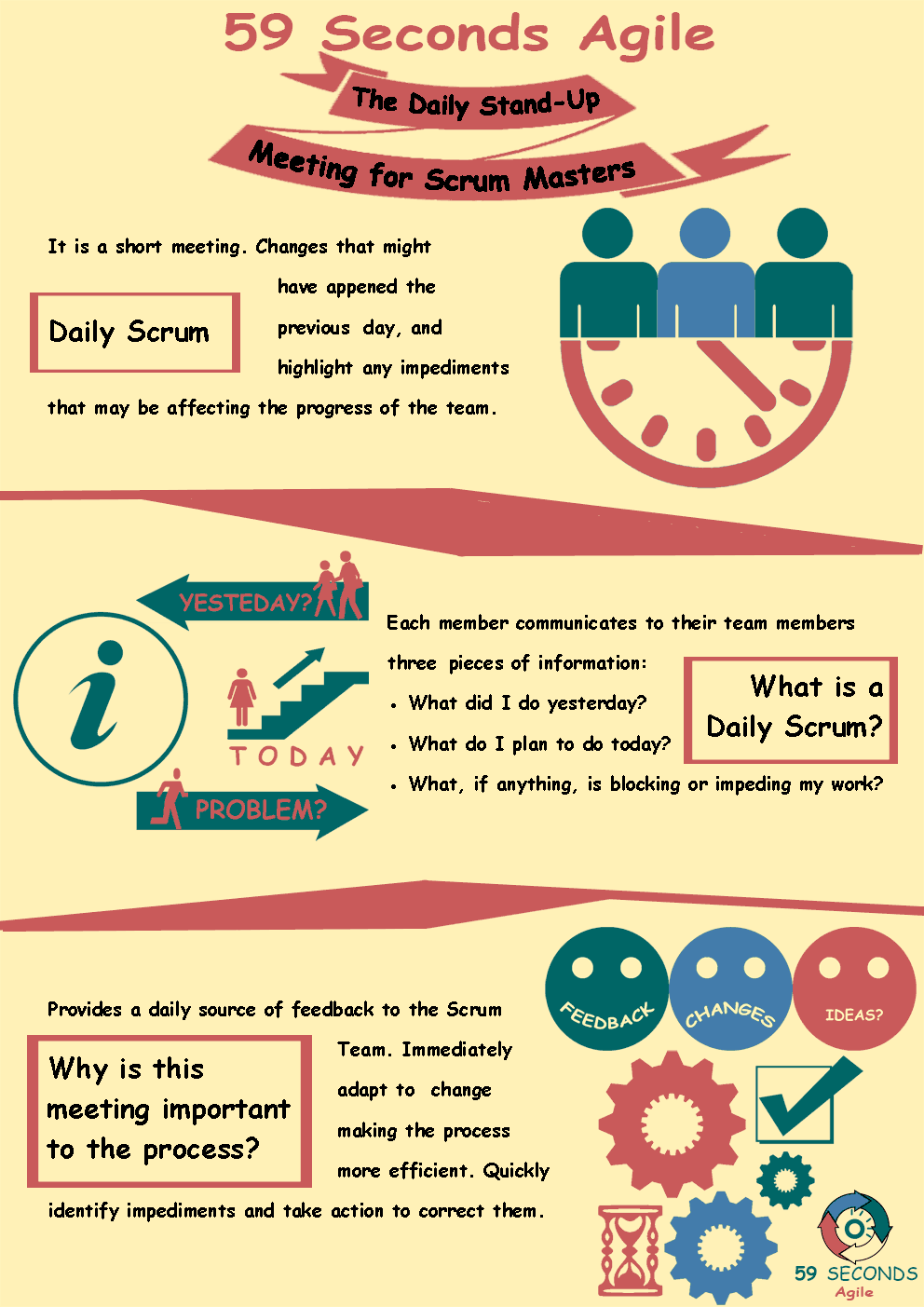
What is the Daily Stand-Up Meeting, when does it take place and who is involved? The Daily Stand-Up is one of the most important ceremonies in a Scrum Project.
The Agile Daily Scrum Meeting
A 59 Seconds Agile Video Animation
The Daily Stand-Up for Scrum Masters
A 59 Seconds Agile Article
The daily scrum is an opportunity for developers or anyone committed to working in the sprint to talk to each other to make sure the entire team is driving to the same goal and working together towards the successfully completing the sprint. It is a short meeting, where those involved in the project interact and keep abreast of any changes that might have happened the previous day, and highlight any impediments that may be affecting the progress of the team. The forcing function of everyone having to stand for it also ensures that is it kept short and that people are physically more engaged and present. It’s a time each day for the team to come together and stay agile.
What is a Daily Scrum?
The Daily Scrum is a daily meeting where the team communicates their current work and highlights any impediments. This raises any issues with the Scrum Master who can then look to quickly resolve them to enable the development team to continue progressing with their work. The only people that should be speaking at this meeting are those that are committed to the sprint. The time-boxed 15 min meeting requires that each member communicates to their team members three pieces of information:
- What did I do yesterday?
- What do I plan to do today?
- Is there anything blocking or impeding my work?
The daily scrum is attended be the developers, designers, testers, and other active development team members. The Scrum Master and, depending on the situation, the product owner may also attend. This is not a report to higher-ups regarding the project status but is a daily commitment to the team of the work that was completed and what you will get done to make sure the team succeeds.
What is a Daily Scrum?
If a developer says during the daily scrum that they will finish a database module during that day’s work, then the team will expect to hear that she finished the module at the next daily scrum. It is not a meeting where a manager is taking notes regarding who is behind and who is ahead, this is a time to commit to the team the work each team member plans to get done.
If impediments are identified during the daily scrum, a conversation should be held after the meeting to find a resolution. This is where the highest value within the Scrum Master’s role can be observed. The Scrum Master’s goal is to always help the team move forward, they are just as committed to the work laid out in the sprint as everyone else on the team. If missing software, broken equipment, or anything that is impeding the work of a team member it is the Scrum Masters responsibility to make sure this impediment is removed as quickly as possible.
Our Favourite Agile Books
We found these books great for finding out more information on Agile Scrum:
The daily scrum meeting should happen at the same time and place every day so it becomes a regular part of the team’s daily routine. Generally towards the beginning of the day is best but find a time where everyone can commit to being there.
Why is this meeting important to the process?
This meeting is key to the scrum process because it provides a daily source of feedback to the Scrum Team. They can use this feedback to immediately adapt to change, making the process more efficient. Through daily updates, the team can quickly identify impediments and take action to correct them before they begin to negatively impact the success of the project.
Prev <— Continue Reading —> Next
Learn More: Agile Daily Stand-Up
User Stories Applied
A 59 Seconds Agile Book Review
User Stories Applied by Mike Cohn is one of our favourite books on Agile User Stories. The book starts with an overview into user stories, and details what a user story is and the different aspects of them. He then discusses how to go about writing a user story, and provides details of the INVEST criteria that can be used to determine if the story is meeting all of its objectives. Next Mike gives an in depth discussion of who user stories are written for and where to begin when gathering the details for them. The book then discusses acceptance testing user stories, including how to go about specifying these criteria and the responsibilities of the development team and customers during this process.
Prev <— Continue Reading —> Next
Learn More: Agile Daily Stand-Up
The Daily Stand-Up Meeting
A 59 Seconds Agile Infographic

Prev <— Continue Reading —> Next
Learn More: Agile Daily Stand-Up
Our Favourite Agile Books
We found these books great for finding out more information on Agile Scrum:

